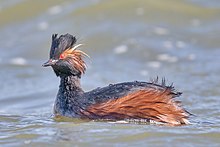Black-necked grebe
| Black-necked grebe | |
|---|---|
 |
|
| Podiceps nigricollis nigricollis, adult breeding plumage | |
 |
|
| Podiceps nigricollis californicus, adult non-breeding plumage | |
| Scientific classification | |
| Kingdom: | Animalia |
| Phylum: | Chordata |
| Class: | Aves |
| Order: | Podicipediformes |
| Family: | Podicipedidae |
| Genus: | Podiceps |
| Species: | P. nigricollis |
| Binomial name | |
|
Podiceps nigricollis Brehm, 1831 |
|
 |
|
| Range of P. nigricollis Breeding Year-round Winter |
|
The black-necked grebe (Podiceps nigricollis), known in North America as the eared grebe, is a member of the grebe family of water birds. It is present in parts of Africa, Eurasia and North America.
There are three subspecies:
Both common names for this species refer to features visible when the bird is in its breeding plumage; in such plumage, it has an all-black neck and a spray of golden plumes on each side of its head. The name "eared grebe" was in use nearly a century before the name "black-necked grebe". The latter was first used in 1912 by Ernst Hartert, in an effort to bring the common name of the species in line with its scientific name. The genus name of this species—Podiceps—comes from two Latin words: podicis, meaning "vent" or "anus" and pes meaning "foot". This is a reference to the attachment point of the bird's legs—at the extreme back end of its body. The specific epithet nigricollis is Latin for "black-necked": niger means "black" and collis means "neck".
The black-necked grebe is 28–34 centimetres (11–13 in) long. The adult is unmistakable in summer, with a black head and neck and yellow ear tufts. In winter, this small grebe is white with a poorly defined black cap, which distinguishes it from the crisper-looking Slavonian grebe (horned grebe in America).
In courtship the male gives a mellow poo-ee-chk call to the female.
This species breeds in vegetated areas of freshwater lakes across Europe, Asia, Africa, northern South America and the southwest and western United States. The North American subspecies, P. n. californicus, is known as the eared grebe (or "eared diver"). These birds migrate in winter, mostly to the Pacific Coast where they range south to El Salvador on a regular basis; vagrants may occur as far as Costa Rica.
Black-necked grebes of the nominate subspecies P. n. nigricollis in the cooler temperate regions of the Old World also winter further south, with many European birds moving to the Mediterranean area. The isolated southern African race, P. n. gurneyi, is sedentary. It was named by South African ornithologist and author Austin Roberts in honour of the English bankers and amateur ornithologists John Henry Gurney and John Henry Gurney Jr..
...
Wikipedia

